|
| |
Presented here, a painting which is
unparalleled in its portrayal of an age-old revered mystical
subject, The Kabbalah, painted by the Russian-European artist,
Ari Roussimoff, whose works have been widely acclaimed and
exhibited in notable galleries and museums, such as Nakhamkin
Gallery of Madison Avenue and Soho and New York’s Nicholas
Roehrich Museum, as well as seventy others around the world.
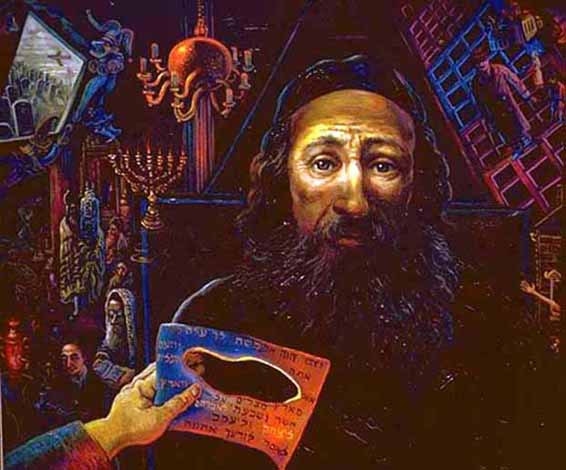
Painted in 1984, this Roussimoff painting,
”EARTH, FIRE, WATER, BEHOLD THE KABBALIST", occupies a
unique place in the artist’s oeuvre and was last exhibited
in 1985, in the Nicholas Roerich Museum, where visitors were
transfixed by its mystical allure. The artist refused to sell
it. He retained the painting in his personal collection for
many years, because he considers its transcendent powers to be
a profoundly creative and personal inspiration. The painting
has not been exhibited for almost twenty years. We invite you
to study the painting and draw yourself into its magical
light. So powerful was the mystical magnetism in the artist’s
creation of ”EARTH, FIRE, WATER, BEHOLD THE KABBALIST”,
that Roussimoff considered himself a vessel for transforming
his vision, using his unique skills and talents, into a
powerfully inspirational work of art. What follows is the
moving story of ”EARTH, FIRE, WATER, BEHOLD THE KABBALIST”,
Roussimoff’s long-time fascination with Mysticism and
Kabbalism, his visits to historic Kabbalistic landmarks around
the world, his poignant encounter with a contemporary
philosopher of Kabbalah, Rabbi Philip Berg many years ago, the
significant personal experience, which led Roussimoff to paint
this truly profound work and,finally, an explanation of the
Mystical and Kabbalist symbols within this complex and magical
painting. ”EARTH, FIRE, WATER, BEHOLD THE KABBALIST” is a
Genuine Signed & Dated Ari Roussimoff Oil on Canvas
Painting, measuring a large-sized 26 x 30 inches.
THE ARTIST’S PERSONAL INVOLVEMENT WITH
SPIRITUALITY, MYSTICISM & KABBALAH
Roussimoff views art and all creativity as being a highly
spiritual process, not unlike prayer. To him all life is
filled with unseen mystery. Kabbalah and Mysticism are
subjects which have pulled at Roussimoff since his childhood,
perhaps in part because he is a direct descendent of one of
the greatest Chassidic leaders and Kabbalists, the illustrious
Rabbi Reb Meir of Premishlan, tales of whom have been
recounted by philosophers, such as Martin Buber. The many
spellings of the word: Cabbala, Quabala, Kabbalah, were even a
fascination to the young Roussimoff. And, he in time came to
see its importance, not only for Judaism, but also for other
religions, as well as inspirational and spiritual schools of
thought. During boyhood, Roussimoff familiarized himself with
Kabbalah oriented literature by great authors, such as
Gerschom Scholem, Dagobert Runes, and numerous other
commentaries on the Zohar, etc. He traveled to that ancient
historic Kabbalist Town of Safed, in Israel, where he painted
on location and experienced great spirituality at important
landmarks.
On a stay in New York in the early eighties Roussimoff
discovered that Touro College was hosting some lectures by the
modern Kabbalist Rabbi Philip S. Berg. Since it was open to
all, he attended several talks and found them highly
inspiring. Rabbi Philip Berg eventually organized a Kabbalah
Centre, which has attracted the interest of many people,
including such notables as Madonna, Britney Spears, Barbra
Streisand, Diane Keaton and Elizabeth Taylor. It is not
surprising that people of all religious denominations are
attracted to Kabbalah today.
In 1984, Roussimoff’s elderly father
suffered a severe stroke, which left him comatose. Doctors
declared him brain dead (One doctor even staked his reputation
on his conviction that his father would never come out of the
coma, and, if he did, he would be in a vegetative state).
Roussimoff, ever believing in other forces, barely knowing
Rabbi Berg, telephoned him and asked the Rabbi to pray for his
father, which the Rabbi agreed to do. After a month-long coma,
sure enough, the doctors’ awful predictions were proved
false, when Roussimoff’s father emerged from the coma.
Although there was some physical damage, his father’s mind
was fully functional, and he lived productively for another
eight years. The hospital proclaimed it a miracle, which was
beyond medical understanding. The painting, ”EARTH, FIRE,
WATER, BEHOLD THE KABBALIST”, was created as a direct
expression of the miraculous recovery of the artist's father.
It is a beautiful melding of both warm and cool colours, while
never obtrusive, with deep and rich hues, and is a modern
inspiration, recalling the traditions of the Dutch and Italian
Old Master painting schools. ”EARTH, FIRE, WATER, BEHOLD THE
KABBALIST” speaks to the mysteries of the universe and the
power of miracles.
THE SYMBOLISM OF ”EARTH, FIRE, WATER,
BEHOLD THE KABBALIST”
Light, Energy, Time
The "Light" of true knowledge glows magically around the
deeply penetrating eyes of the wise and holy
Kabbalist.
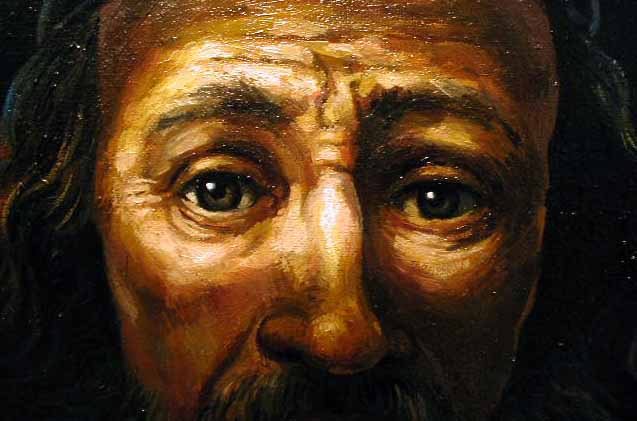
Here certainly, the Sage's eyes provide a mirror to the
soul.
Like the Alchemist of Medieval Europe, who
pursues his Alchemy within highly personal passions not
commonly understood, so too does the Kabbalist, who has
brought himself to a higher plateau of knowledge, one not
often comprehended by even those sharing equal piety.
Roussimoff has made an intense study of the unique use of
light employed by Rembrandt in paintings, such as
"Aristotle Contemplating the Bust of Homer". In ”EARTH,
FIRE, WATER, BEHOLD THE KABBALIST”, the light seems to
emanate both internally and externally, signifying that the
revered Kabbalist is both illuminated with the light of the
universe, while at the same time enlightening all that
surrounds him. Ornate gold candelabras and chandeliers are
symbols of light everlasting, since the beginning of human
kind.

Light also assumes the form of electricity, both in the
modern sense and in the purest sense of energy, an
overwhelming power (knowledge), which must be hidden in order
to be properly used and then only for good. Everything is
interrelated. There are references to Earth, Fire, and Water.
Mystical triangles
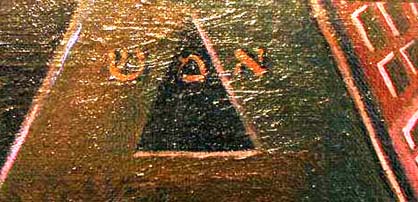
evolve into simple compositional planes designating the
interior and
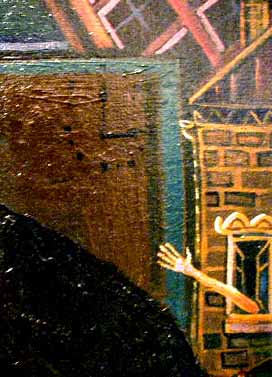
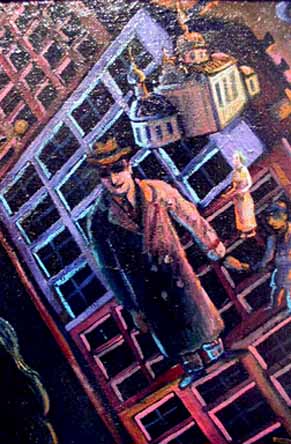
also serve to frame exterior scenes of streets and
industry. There is a topsy turvey and almost chaotic feel to
an industrial street where, in full contradiction to this
setting, a father strolls most calmly with his playful little
son with the mother watching protectively, knowing full well
that their lives will be fulfilled. Just above them, a Church
building floats in the distance, symbolizing the universal
attraction and vitality that Kabbalah has had throughout
history for many Christians as well as Jews.
Time is eternal, as represented in the depiction of the
clocks. Life, Death, Reincarnation, Resurrection are all
integrated into the composition. Biblical predictions are
integrated with elements of the past, present and future. A
hand thrusts forth a note featuring Hebrew
calligraphy.
This is from a Biblical text that relays how the Creator
presented the future to Moses, reinforcing that which was also
promised to Abraham. The empty circle which appears in the
center of the text does not in any way represent emptiness. On
the contrary, as the Bible can be understood through the
practice of Kabbalism, it's essence can be fulfilled by the
active Kabbalist. Thus, the shape of the circle
mirrors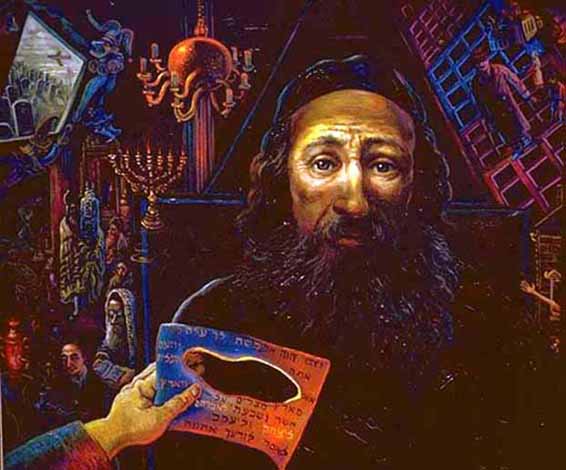
the shape of the spiritual light which encircles the
Rabbi's eyes, thereby making possible the fulfillment of all
Holy Scripture via the will of mankind. In the center left of
the painting is a Sabbath Service in a Hassidic Synagogue.
Founded in 18th Century Ukraine by Rabbi Israel Baal Shem Tov,
early Hassidism was strongly inspired by Kabbalah, and many of
the legendary Rabbis were alleged to have miracle-working
powers, such as Rabbi Levi Isaac of Berditchev and the
artist's own ancestor, Rabbi Meir of Premishlan. People (both
Jews and Non-Jews) came from far and wide to seek their
guidance. One sees the pious Rabbi passionately holding the
Torah Scrolls to his heart during the Holy Sabbath,
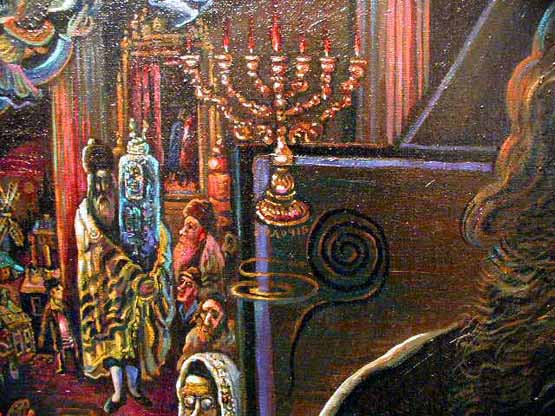
with the life of the small Russian town (shtetl) in the
background,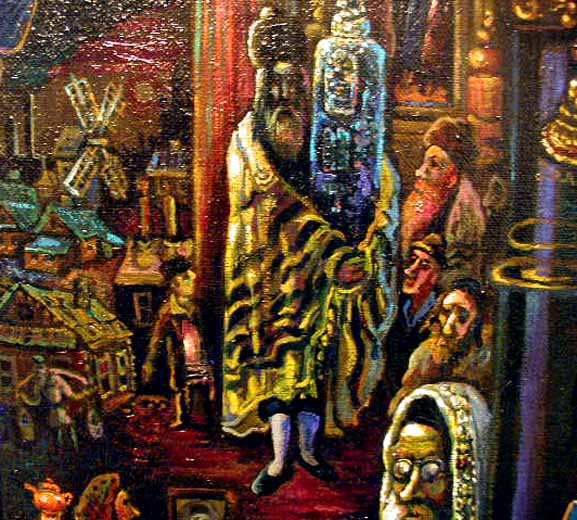
the artist's ancestral dwellings.
The small window on the upper left features an ancient
cemetery.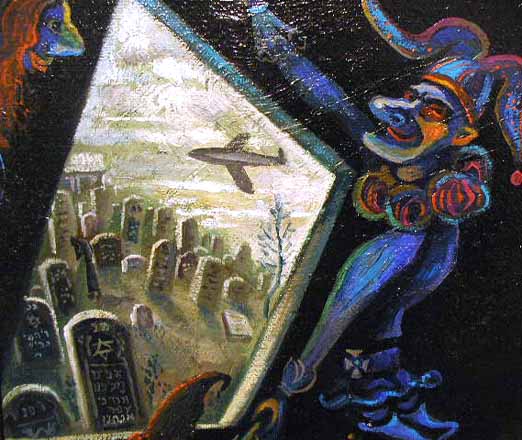
The airplane coming through the sky represents high energy
life-force, which the artist relates also to the idea of the
afterlife (Olem Habeh). Surrounding the window is a seemingly
enigmatic circle of dancing Court Jesters, symbolic of an
illusion of frivolous joy in those who remain in the darkness.
In the upper right of the painting is a scene that shows how
our destinies are in our own hands.
MIRACLES
On the bottom right of the painting is a
table with a boiling samovar. This scene symbolizes Roussimoff’s
father’s miraculous recovery from his devastating stroke.
The father (Roussimoff's father)and his son(depicted as a
child to symbolize innocence) study scripture, as the spirit
of the ancient Kabbalist Rabbi Shimon Bar Yochai, author of
the Zohar, chants prayers nearby.
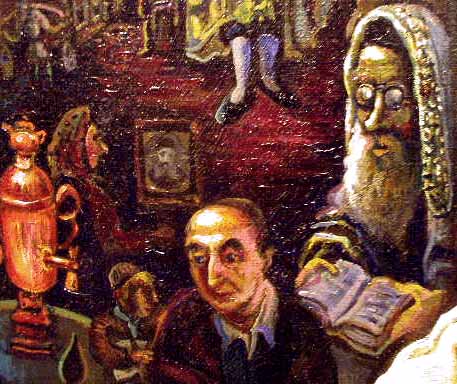
The present and past are but one.

The painting comes with a handsome wooden frame that was
especially custom-commissioned for it.  |
|
|
|
|
|
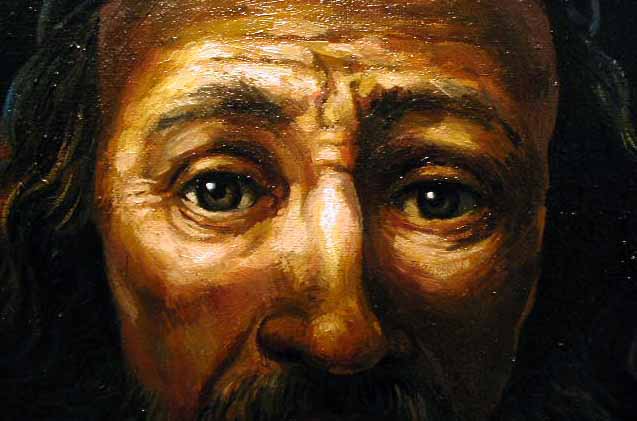
|
|
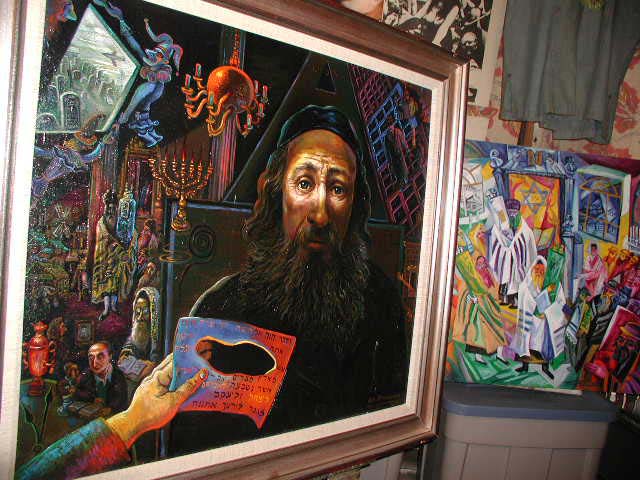
"EARTH, FIRE, WATER, BEHOLD THE KABBALIST"
Oil on Canvas by Ari Roussimoff
|
| | | |
|